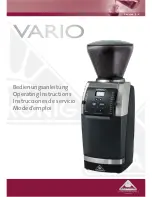
Constant speed
The preselected motor speed is kept constant
through electronic control. This ensures a uni
form speed even when under load.
Temperature cut-out
To avoid the motor overheating, the power con
sumption is limited at an excessive motor tem
perature (e.g. if the pressure is too high while
working). If the temperature continues to rise,
the power tool switches off. It can only be
switched on again once the motor has cooled
sufficiently.
6.3
Handle position
Loosen the handle screw [1-5] as much as nec
essary and set the handle [1-6] to a suitable
working position by tilting it. Then tighten the
handle screw [1-5] again.
6.4
Sanding discs
Depending on the application area, various
sanding discs are available. Use solely discs of
Festool, which guarantees the sanding output
of the RG 130 ECI.
Recommended sanding disc types
Sanding
disc
Field of application
Speed
range
DIA STONE-D130
Very hard materials,
e.g. concrete with a
strength higher than
C20, cast concrete
6
DIA HARD-D130
Hard materials, e.g.
concrete with a
strength higher than
C10, hard screed
6
DIA ABRASIV-D130
Soft materials with a
higher level of abrasion,
e.g. fresh concrete, ad
hesive coatings, hard
plaster, sandstone
6
Sanding
disc
Field of application
Speed
range
DIA PAINT-D130
Large and thick layers
of paint or varnish, e.g.
on floorboards, wooden
façades and doors
4–6
DIA THERMO-D130
Tough and thermoelas
tic materials, e.g. pro
tective coatings, elastic
adhesives
5–6
Installing the abrasive wheel
CAUTION
Risk of injury from hot and sharp insertion
tool
► Do not use any blunt or faulty insertion
tools.
► Wear protective gloves when handling an
insertion tool.
WARNING
Risk of injury from the fragile sanding tool
► Ensure that the sanding tool's expiry date
has not been exceeded.
► Clean the flange [2-1] and fastening
nut [2-4] as well as sanding disc fastening
areas [2-2].
► Mount sanding disc. Flange fitting must fit
the sanding disc aperture.
► Press in the spindle blocking plunger [2-3].
Press in the blocking plunger only when de
vice is switched off and spindle not active.
► Turn the spindle [2-6] until blocking plung
er fits in.
► Screw the fastening nut by fitting it from the
sanding disc on the spindle.
► Fasten the fastening nut with key [2-5].
► Before starting the device, make sure the
sanding disc rotates smoothly.
The intermediate layers supplied with the
sanding discs are not required.
6.5
Brush
Lifting the front brush
For wall lifting, it is possible to lift the lifting
segment [3-1] (see figure [3]).
English
22
















































